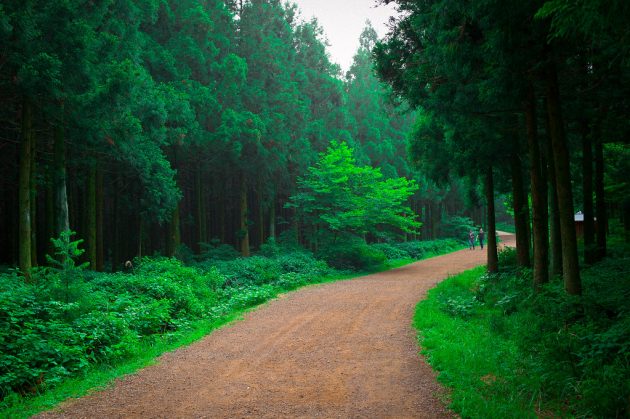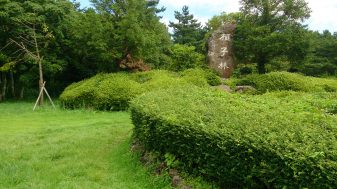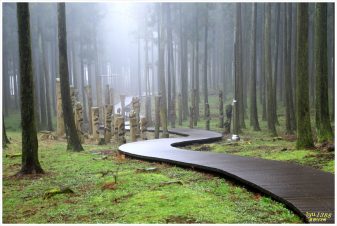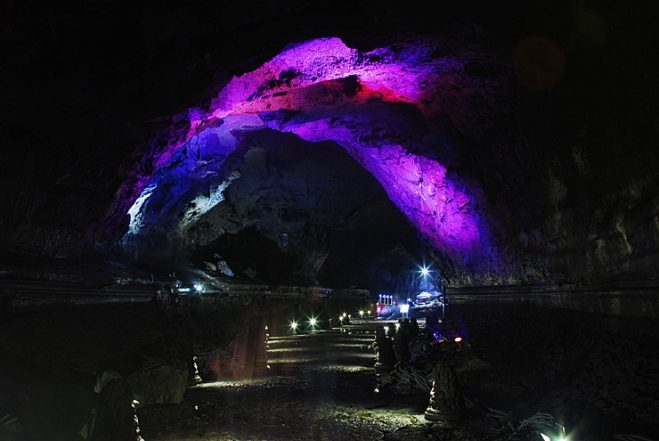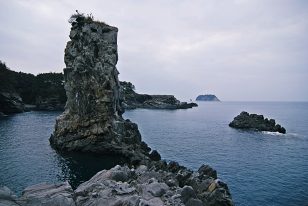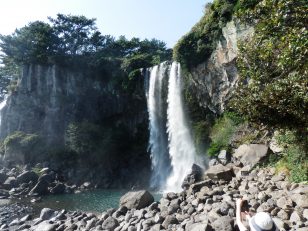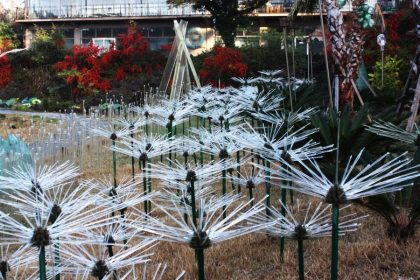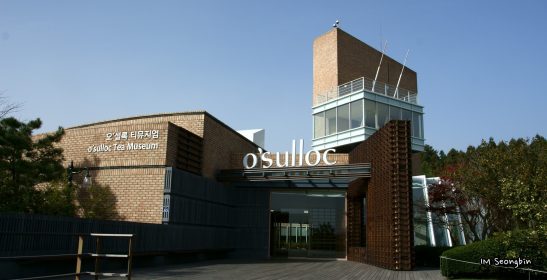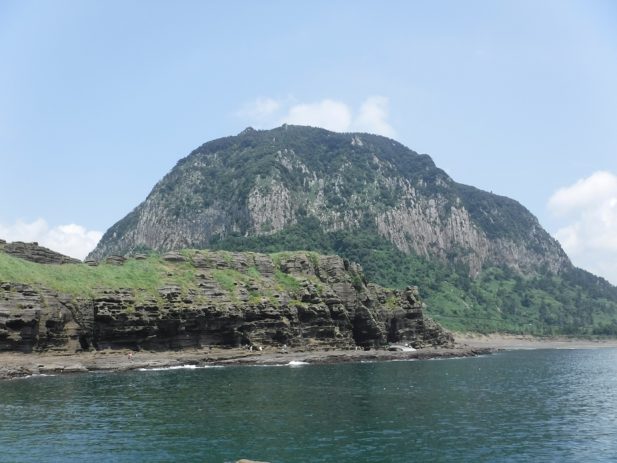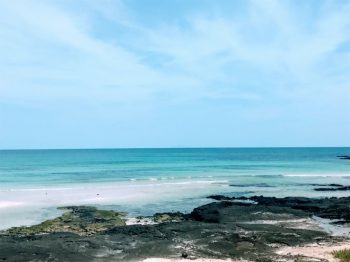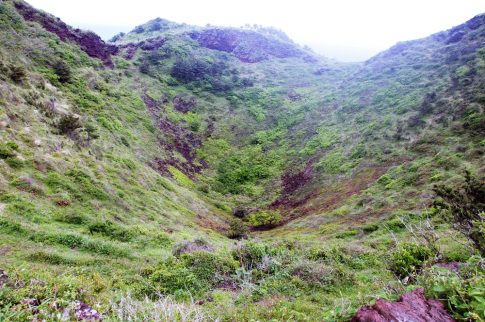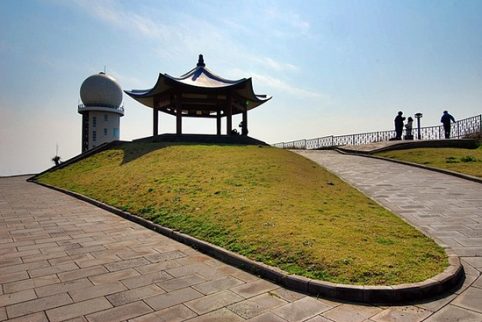Only one hour a half flight away from Seoul, Korea’s tropical island, the picturesque Jeju has it all: from gorgeous beaches to relax, to beautiful natural formations, eccentric museums and parks, and other great attractions. To help you get the best out of Jeju, OnedayKorea compiled the most unique things to do on this beautiful island.
Take your time and enjoy a walk in one of Jeju’s splendid forest
Bijarim Forest has a group of about 2,800 nutmeg trees between 500 and 800 years old, making it the largest nutmeg tree forest in the world. Most of the trees stand between 7 and 14 meters but, in the middle of the forest, you will find an 800-year-old tree – the oldest one on Jeju island – that has a height of 25 meters and a girth of 6 meters.
Nutmeg trees are known to produce phytoncide which strengthens the immune system and the natural healing ability of the human body. Walking through the forest and breathing the fresh air will not only appease your soul but also your body.
Jeolmul Natural Recreational Forest is located northeast of Hallasan Mountain and is famous for its beautiful Japanese Cedar Trees. Jeolmul Oreum (a small extinct volcano within a main volcanic crater) is about 697 meters high, so the peak, in the middle of the forest, offers spectacular views over the East coast of the island.
This forest is perfect for a family outing, as it features a promenade path easy enough for all ages, a pond, an observatory, and a grass square.
Saryeoni Forest is cut through by a beautiful path that enables hikers and cars to cross this dense forest of Japanese Cedar Trees between Mulchat Oreum and Saryeoni Oreum.
This path is very famous among locals like tourists for healing and meditation; some people even walk barefoot to fully experience the proprieties of the soil of the forest. The forest is also well known to house many wild animals like deer, boars, badgers, woodpecker birds and snakes.
Get in touch with Jeju’s beautiful natural monuments
Jeongbang Waterfall is the only waterfall in Asia that falls into the ocean. This waterfall is one of the three main waterfalls of Jeju, it stands 23 meters high above the sea level, and its two streams falling into the ocean create a thrilling sound and a beautiful and scenic view to admire. At the top of the cliff, you will find an observatory which offers a splendid view of the coast and the ocean. Take the best pictures and enjoy the splash of the waterfall from up close with our 10D9N Highlights of Korea Group Tour.
Manjanggul Cave is one of the best lava tunnels of the world: it was formed when the lava that was deep in the ground came to the surface. Only one kilometer of the 13,422 km of the lava cube is open to visitors.
During your visit – you will have to bring comfortable shoes and a jacket as the ground is quite slippery and the temperature drops once in the cave – you will see unique lava structures, and the most impressive is the 7.8-meter high lava column at the end of the walk. You might also encounter some rare animals such as the resident bats that come for the darkness and cold of this huge cave.
Oedolgae Rock sits not far from the Seogwipo coast, in the south part of Jeju. This colossal rock stands 20 meters and has a circumference of 10 meters and is surrounded by the sea and beautiful islands.
As the legend tells, a Grandmother, turned into rock, while waiting for her husband to come back from the sea. The location is filled with hiking trails and is a hotspot for watching the sunset. Get ready to have your breath taken away by the winter scenery of this place during our 10D9N Korea Winter Package.
Yongduam Rock (Dragon Head Rock) was formed by violent volcanic forces, thousands of years ago and its unique shape of a dragon’s head was carved by the waves and the wind.
But the legend says otherwise: according to the stories, this 10-meter tall rock is the frozen head of a dragon that stole a jade from the Hallasan Mountain. One of the gods shot an arrow at the thief, and the dragon fell from the sky into the sea, and his head froze as his body sank into the water.
Spend an afternoon in one of the many theme parks and museums of Jeju
Jeju Glass Castle is a museum displaying the glass artwork of artists from around the world. The colorful collection is divided into an indoor and an outdoor section, each showcasing beautiful and delicate glass structures.
In the indoor part of the museum, you can learn more about the art of glass-shaping and make some vase, plate or candle for yourself.
Another strange experience to try: the outdoor toilets of Jeju Glass Castle are also made of glass, but while you can see everyone outside of it, people can’t see you inside.
Jeju Waterworld is a family-friendly water park that offers something for all ages. It’s the largest water leisure park of Jeju and a favorite among locals and tourists alike.
From tots to adults everyone will find a way to enjoy this place to the fullest with the multiple pools, the Jimjil-bang and much more. There are even a fitness center and a high-class indoor golf practice range.
O’sulloc Tea Museum teaches visitors about Korea’s (and more specifically Jeju’s) tea culture. The name of the museum stands for the name of the famous Sulloc tea.
In this museum, you can enjoy various kinds of Sulloc teas, relax by the lotus pond in the indoor garden, and, thanks to the observatory on the second floor, admire the beautiful nearby green tea fields. This romantic and amazing place is perfect for a Honeymoon Tour.
Come eat the delicious specialties of Jeju
Dongmun Market is probably the best traditional market in Jeju Island. Over 300 vendors are lined up along the narrow streets and sell all the fresh and high-quality food that the island has to offer: black pork skewers, abalones cooked in every way you can think of, grilled mackerel, spicy seafood hot pot, hairtail fish and many more.
The market, which was first built in 1945 following Korea’s liberation from the Japanese colonial rule, was burnt to ashes in 1954. The market reopened at the current location and kept its original name.
Enjoy the gorgeous shores of the Hawaii of Korea
Woljeong-ri Beach is the beach of your dreams: white sand and clear blue water in which you can refresh yourself during the hot Korean summer.
Well known for its beautiful scenery, the path leading to the beach is filled with tea houses and coffee shops where you can buy your favorite iced beverage and a snack to enjoy the day to the fullest. In addition, a drive along the beach is a great way to appreciate the exotic landscapes of Jeju-do and better understand why the island is called the Hawaii of Korea.
Hamdeok Beach, located 14 km east of Jeju City, is famous for its clean and shallow waters. There is a sandbar separating the shore from the open ocean, which is why the swimming area of Hamdeok Beach is far more warmer than other beaches of Korea.
On top of that, If you’re into water sports, the beach has all of the facilities you need and if you’re more of a lie-down and sleep person, no worries, there’s plenty of space to take a nap on the beautiful sandy beach. There is also a small arched bridge that connects to a small island where you can take memorable pictures. Have the time of your life on this beach with our Private Jeju Island Tour.
Yongmeori Coast is located in the south part of Jeju and is one of the most beautiful landscapes of Jeju. The whole shore was formed millennia ago by the cooled lava of Mount Hallasan’s eruption.
People say the shape of the stone cliff looks like a dragon raising its head to dive right in the sea. Another magical thing about Yongmeori Coast? Between the rocky cliffs, you can find a black sand beach.
Reach for Jeju’s sky through the island’s magnificent mountains
Suwolbong Peak is located on the most western point of Jeju Island, and is surrounded by acres of green fields and faces the beautiful sea.
Standing at 77 meters high above the sea level, you will have the perfect view to watch the sunset, but also see Chagwido, Songaksan Mountain and Jukdo Island. Dotted along the base of the shores, hikers can see hideout caves dug by the Imperial Japanese Army during the Second World War. Just below the peak, there is a small Buddhist Temple where you can enjoy the mineral water that falls from the cliff.
Songaksan Mountain also called 99 Bong due to its 99 small peaks, is located in the southwest part of Jeju and is a perfect example of the island’s volcanic past.
Along the hike that follows the cliffs of Songaksan, you will find traces of volcanic activity through the important geological formations as well as the 80-meter deep crater where you still can find some blackish ash inside. You will be also amazed by the lush vegetation: thick grass, pine trees, and other tree species.
Read more about Jeju Island:
Sharing a secret place of Jeju island : Jeju Olle trail
Why Soesokkak Estuary is a charming place to explore?
Dol Hareubang: Jeju-do’ stone grandfather
Now that you know about what the beautiful island of Jeju has to offer, is it on your travel list yet? If so, don’t forget to check out our Jeju Tours or create your custom itinerary and send us an email at info@onedaykorea.com so we can make your dream vacation happen!
Check our main website for the largest selection of Korea Private Tours

